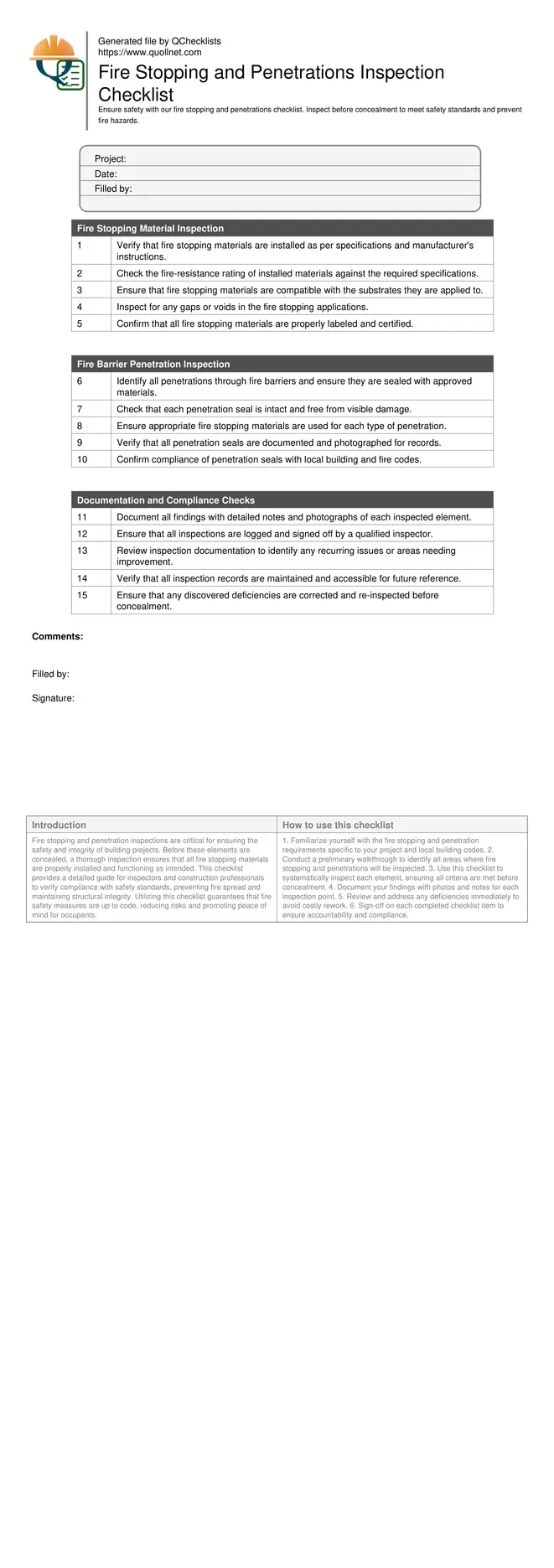Comprehensive Fire Stopping and Penetrations Inspection
Fire stopping and penetration inspections are critical for ensuring the safety and integrity of building projects. Before these elements are concealed, a thorough inspection ensures that all fire stopping materials are properly installed and functioning as intended. This checklist provides a detailed guide for inspectors and construction professionals to verify compliance with safety standards, preventing fire spread and maintaining structural integrity. Utilizing this checklist guarantees that fire safety measures are up to code, reducing risks and promoting peace of mind for occupants.
- Ensure all fire stopping materials are correctly installed and compliant with safety standards.
- Verify that all penetrations through fire-resistant barriers are adequately sealed.
- Identify potential fire hazards before walls and ceilings are closed up.
- Facilitate compliance with building codes and regulations for fire safety.
- Prevent costly rework by catching issues early in the construction process.
Fire Stopping Material Inspection
Fire Barrier Penetration Inspection
Documentation and Compliance Checks
The Importance of Inspecting Fire Stopping
Inspecting fire stopping is crucial to ensure the safety and compliance of any building. Fire stopping materials are designed to prevent the spread of fire and smoke through openings made for pipes, ducts, and cables. An effective inspection ensures that these materials are properly installed and that they will function as intended in an emergency situation. This not only protects the building structure but also saves lives by providing extra time for evacuation.
- Evaluate the installation of fire stopping materials.
- Ensure materials meet the required fire-resistance rating.
- Check for any visible gaps or improper installations.
- Verify compatibility of fire stopping materials with substrates.
- Ensure compliance with local fire safety regulations.
Understanding Penetrations in Fire Barriers
Penetrations in fire barriers are necessary for the installation of utilities but must be carefully managed to maintain the integrity of fire-resistant constructions. Inspections focus on ensuring that all penetrations are sealed with approved materials to prevent fire spread. Proper management of these penetrations is critical for maintaining the overall fire safety of the building and ensuring compliance with safety codes.
- Identify all utility penetrations through fire barriers.
- Ensure each penetration is sealed with approved fire stopping materials.
- Check for any unprotected or improperly sealed openings.
- Confirm all materials used are properly labeled and certified.
- Document the condition and compliance of each penetration.
How to Use This Inspection Checklist
- Familiarize yourself with the fire stopping and penetration requirements specific to your project and local building codes.
- Conduct a preliminary walkthrough to identify all areas where fire stopping and penetrations will be inspected.
- Use this checklist to systematically inspect each element, ensuring all criteria are met before concealment.
- Document your findings with photos and notes for each inspection point.
- Review and address any deficiencies immediately to avoid costly rework.
- Sign-off on each completed checklist item to ensure accountability and compliance.
Call to Action
- Start Checklist Tick off tasks, leave comments on items or the whole form, and export your completed report to PDF or Excel—with a built-in QR code for authenticity.
- Download Excel - Fire Stopping and Penetrations Inspection Checklist
- Download PDF - Fire Stopping and Penetrations Inspection Checklist
- View Image - Fire Stopping and Penetrations Inspection Checklist
